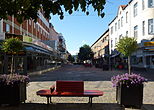Ludvika
| Ludvika | ||||
|
||||
| State : | Sweden | |||
| Province (län): | Dalarna County | |||
| Historical Province (landskap): | Dalarna | |||
|
Municipalities : |
Ludvika Smedjebacken |
|||
| Coordinates : | 60 ° 9 ′ N , 15 ° 11 ′ E | |||
| SCB code : | 6624 | |||
| Status: | Crime scene | |||
| Residents : | 15,245 (December 31, 2015) | |||
| Area : | 11.14 km² | |||
| Population density : | 1368 inhabitants / km² | |||
| List of perpetrators in Dalarna County | ||||
Ludvika is a city in central Sweden . It is located in the south of the historic Dalarna province on Lake Väsman . Ludvika is the capital of the municipality Ludvika in the province of Dalarnas län with 14,018 inhabitants . A small part (79 hectares ) of the area of the place with 421 inhabitants (2015) belongs to the neighboring municipality of Smedjebacken to the east .
history
In 1539, it is estimated that only 30-50 people lived in the small town in the Bergslagen mining region . Around 1550, King Gustav Vasa had an ironworks built on the Ludvika river (with a drop height of about 17 meters), which began production in 1552 and was the first of its kind in Sweden. In relation to other hut locations in Bergslagen, however , the Ludvika kronobruk was insignificant; but for a long time it was the dominant economic factor in the area. The first "competition" arose in 1900 from the company Elektriska Aktiebolaget Magnet , which, however, had to struggle with profitability problems and was finally sold in 1916 to ASEA from Västerås .
In 1919, Ludvika was granted city rights , with a population of 3937 .
traffic
Ludvika was an important railway junction for a long time : in 1858 one of Sweden's first railway lines was built here, the narrow-gauge Wessman – Barkens Jernväg . It connected Ludvika with Smedjebacken and the Strömsholm Canal , which was an important transport axis for goods and travelers between Bergslagen and Lake Mälaren . In 1873 the line to Frövi and in 1900 with the Kolbäck – Ludvika line a connection via Västerås to Stockholm was put into operation. Together with the railway line to Sälen and an ore railway from the neighboring Grängesberg to Oxelösund , there was at times train traffic in four directions. In the 1970s the volume of traffic decreased and Borlänge took over the function as a railway junction.
Ludvika railway accident
On January 13, 1956, a serious railway accident occurred near Ludvika : a freight train and a railcar , mostly occupied by school children, drove towards each other on a single-track line . As planned , the freight train should have waited in Ställdalen station for the oncoming railcar, but it didn't. This resulted in a head-on collision between the two trains. 20 people died and nine were also injured.
economy
Today the electrical company ABB (formerly ASEA) is the most important employer in the city.
Attractions
In the former mining town, you can visit the Ludvika Gammelgård mine museum, founded in 1938 and, according to the company, the first open-air museum of industrial history in the world.
Town twinning
A town partnership exists with Bad Honnef in Germany .
Personalities
- Erik Hjalmar Lundqvist (1908–1963), track and field athlete
- Martin Lamm (1929–1983), artist and illustrator
- Bosse Broberg (* 1937), jazz trumpeter
- Rolf Zetterlund (* 1942), bandy and soccer player
- Anders Kallur (* 1952), ice hockey player
- Marie Risby (* 1955), cross-country skier
- Fredrik Söderström (* 1973), football player
photos
Ludvika stadshus, architect Cyrillus Johansson 1937
Web links
Individual evidence
- ↑ a b Statistiska centralbyrån : Land area per Tatort, folkmängd and invånare per square kilometer. Vart femte år 1960 - 2015 (database query)
- ↑ Statistiska centralbyrån : perpetrators 2015 som delas av commungräns (Excel file)
- ^ Peter WB Semmens: Catastrophes on rails. A worldwide documentation. Transpress, Stuttgart 1996, ISBN 3-344-71030-3 , p. 154.









